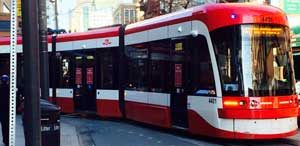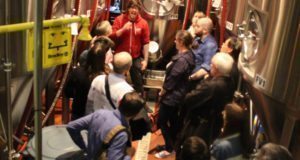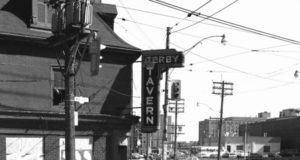Eric Morse –
Compared to the relatively massive areas surrounding it (West Don Lands, Regent Park, St. Lawrence, Corktown is a microcosm. Its business and residents association bylaws used to define it as “that area in the City of Toronto bounded by Shuter Street, Lakeshore Boulevard, Berkeley Street and the Don River.” In Corktown the issues are fought doorway by doorway, and as a local realtor once noted, “it changes from block to block.” The population is rapidly expanding; retail occupancy as well, and now Corktown itself has expanded. At its AGM held Feb. 5 CRBA formally annexed the area between River Street and the Don River between Shuter Street and Dundas Street. The block east of River between Dundas and Shuter, which now includes many new residents, has been a community orphan for many years, being cut off from the west by Regent Park (from which it is wholly different in nature) and by the Don River. Joining a revitalized Corktown RBA is a logical step, fuelled by residents’ concerns about high-rise encroachment in the area as a result of the Regent Park redevelopment, as reported in the last issue of The Bulletin.
Corktown itself faces issues of urban geography, being cut in two by the Richmond/Adelaide overpasses to the Lower Don Bridge, There is ongoing discussion about whether and how the space under them can be made into useful parkland. In the coming year Corktown will also face some disruption from the rerconstruction of Cherry Street and the new TTC streetcar line on it.

Outgoing President Larry Webb identified four areas of outstanding concern for the association is growing the board of directors. Though it’s an old neighbourhood, Corktown is rediscovering itself as a community and organizational growth is slowly catching up. They’re finally getting a working liaison committee formed of all stakeholders to work with the Good Shepherd Centre on the relationship between the Centre and the neighbourhood. Priorities include: Getting something moving in terms of the Parks in Lieu of Development fund, starting a parks inventory and study on how to use the considerable sum of money accumulating in the fund.
For 2013, plans are afoot to create distinctive heritage plaques for sites in the area, and a team of seven Ryerson urban studies students has been commissioned to do a survey of heritage properties.
There’s an increase in retail development on King and Queen, which Webb termed a very favourable sign of things to come. In a very small and diverse area even a few unoccupied storefronts matter and Web called attention to the frontage at 111 – 117 Queen in the Sumach-River block which has been unoccupied for many years. The association has only recently succeeded in tracing the owners and will attempt to open discussions with them as to the fate of the properties.
The size and the amount of density growing around it may foster a certain sense of being under siege since Corktown’s own residential and commercial development remains low-density. During a discussion with MPP Glen Murray, outgoing board member James Caldwell expressed concern that in the new mixed-income developments, the low-income buildings in Regent Park and West Donlands are concentrated on the borders of Corktown. The meeting elected a new board of directors composed of local resident and business representatives. Members are: Alex Bartlett, Peter Coish, Matt Elliott, Adam Holmes, Kara Isert, Sandra Iskandar, Mike Kapil, Lawrence Lui, John MacEwen and Arthur Sinclair. Four are returnees from the 2012 board.
For a tiny association, the CRBA has a remarkably active schedule, with regular speakers and Arts Nights promoting local artists.
A successful event was held Jan. 8.
The next one, scheduled for May 7, will be an Arts and Business Evening organized by re-elected arts chairwoman Sandra Iskandar.
The new board will name a president at its first meeting. For further information on doings in Corktown and CRBA, visit www.corktown.ca.
 TheBulletin.ca Journal of Downtown Toronto
TheBulletin.ca Journal of Downtown Toronto


